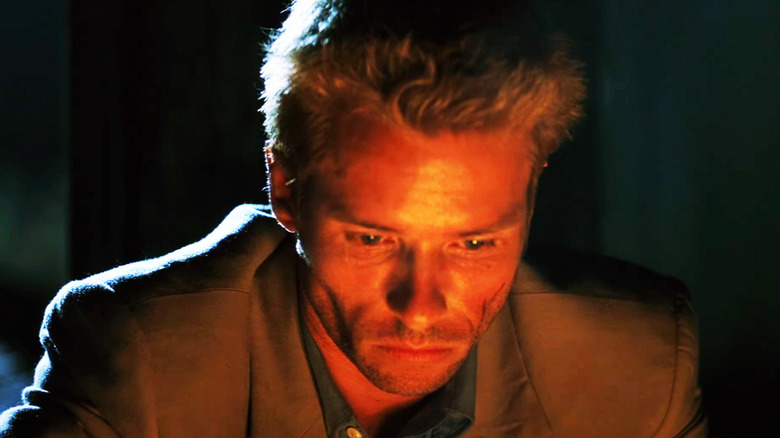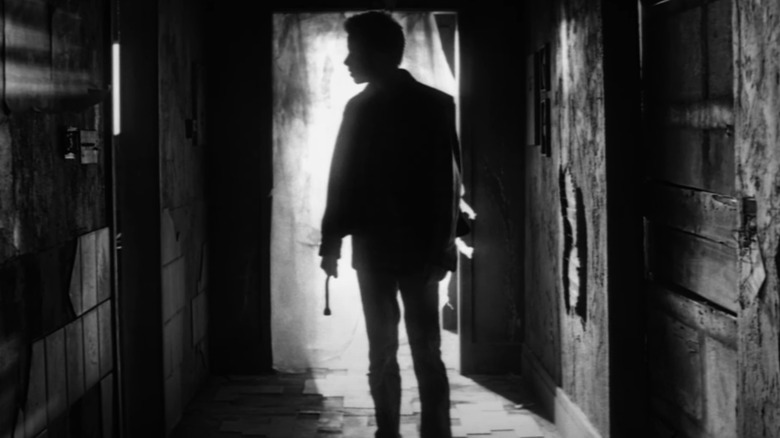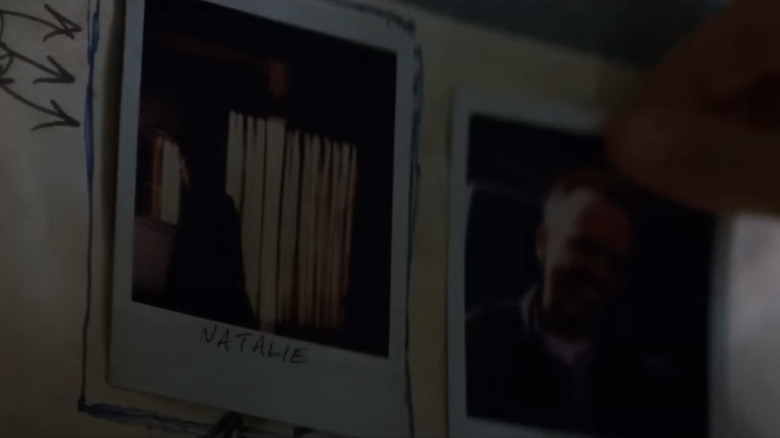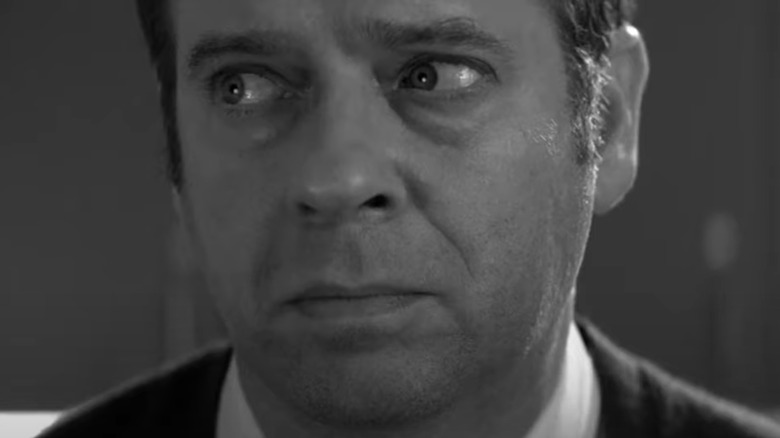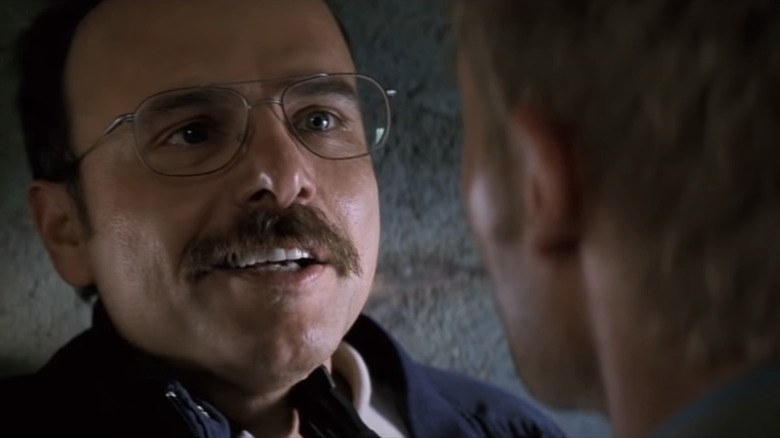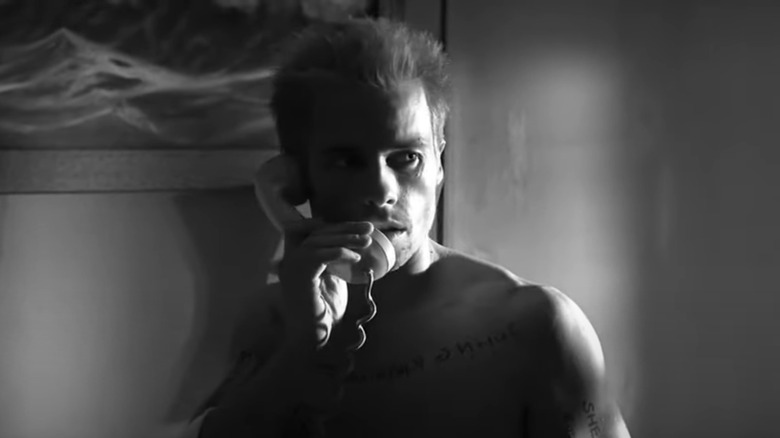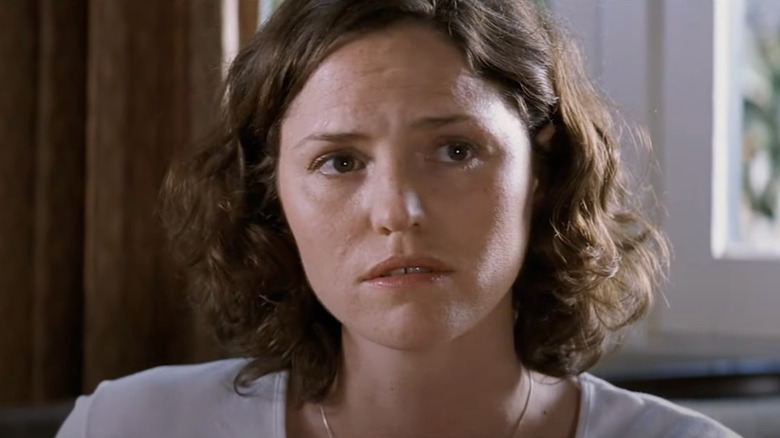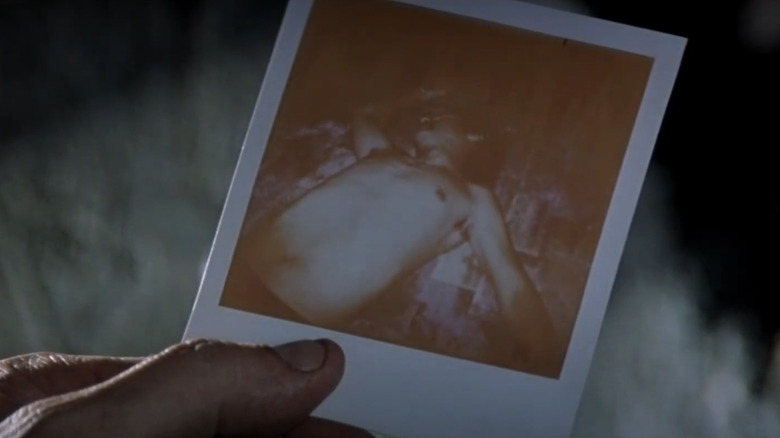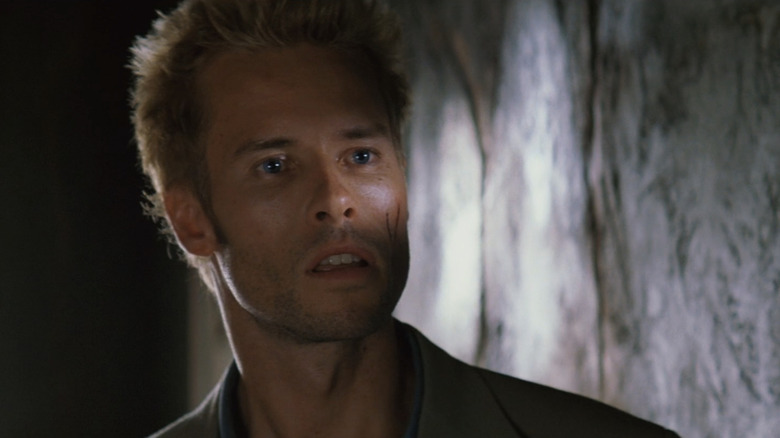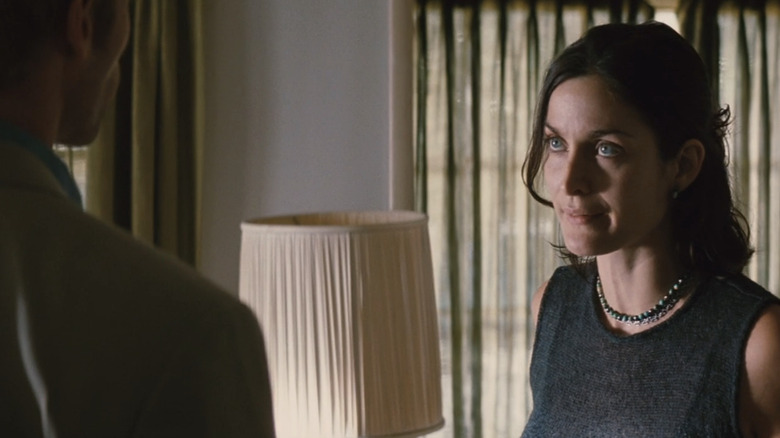The Most Confusing Moments In Christopher Nolan's Memento, Explained
Long before he confused the heck out of all of us (and Quentin Tarantino, apparently) with "Tenet," Christopher Nolan was producing scripts so perplexing that even veterans like Leonardo DiCaprio and Guy Pearce didn't understand them. Tom Hardy has admitted to taking a leap on the script for "Inception," which he claimed was a "bit complicated," and Nolan even confused himself by including a famous line in "The Dark Knight" that he didn't understand.
So, even if you're a Nolan fan, you're likely used to being befuddled by the director's efforts. But the man basically announced his arrival in Hollywood as a filmmaker with a penchant for the perplexing. After self-financing his first film, "Following," which contained several Nolan trademarks including a non-linear narrative, the director found himself with a modest budget for his studio debut, "Memento." Rather than dispose of any complex filmmaking techniques for this film, however, Nolan refused to dumb things down, delivering a mysterious and cerebral neo-noir thriller that many who saw the film upon its 2000 debut still don't fully understand.
"Memento," based on a story by Nolan's brother Jonathan, follows Leonard Shelby (Guy Pearce) a former insurance investigator with anterograde amnesia, which means he suffers from a serious case of short-term memory loss and is unable to form new memories. As the film unravels, we see how Shelby uses his own notes, Polaroid photos, and tattoos to search for whoever attacked him and killed his wife. Oh, and the whole thing is told both in reverse and in a traditional linear narrative form. So, if you find yourself confused by "Memento," you're likely not alone. Thankfully, this article should clear up any lingering confusion and help us solve the mystery of Nolan's first major film.
Why does Memento use black and white and color?
Anyone who saw the Oscar-winning "Oppenheimer" will have noticed Christopher Nolan's use of black and white for more objective scenes and color for J. Robert Oppenheimer (Cillian Murphy)'s subjective experience. But this wasn't the first time Nolan used differing cinematography to distinguish between timelines.
In "Memento," the color scenes proceed (or recede) backwards, whereby each new scene actually occurs prior to the one it succeeds. Within the timeline of the film, these color scenes tell the story in reverse. But Nolan also shoots scenes in black and white, and these are all progressing in a standard, linear fashion. The director cuts back and forth between color and black and white, making it difficult to discern that the monochrome scenes are actually progressing forward. Eventually, we learn these black and white scenes are flashbacks to moments that occurred before the events being recounted in the color scenes. In essence, then, the past is depicted in black and white and flows forward, while Leonard Shelby's present is recounted in reverse.
Nolan has explained the structure of "Memento" using a "hairpin" diagram to demonstrate how the color and black and white scenes are essentially mirroring each other in terms of the direction in which they flow. The two timelines ultimately meet towards the end of the film, during the moment after Lenny kills Jimmy Grantz (Larry Holden) and takes a photo of his body. As the Polaroid develops, the monochrome frame slowly turns to color, signifying the two timelines have finally met. For now, just think of Nolan's use of color and black and white as a way to distinguish between Shelby's present and flashbacks to the past.
Why does Memento use two timelines?
This black-and-white versus color stuff is all well and good, but what's the point of it all? Well, when it comes to the color timeline, Lenny is unable to form new memories after the point he and his wife were attacked in their home. As such, his present is a constant process of discovery. The color timeline unraveling in reverse gives the audience a similar experience to that of Lenny's.
At the start of the film (which is actually the ending of "Memento"), Lenny kills Teddy (Joe Pantoliano). As the film continues we learn that Teddy was actually a cop who was using Lenny as his personal lackey. But when the film opens, we've essentially seen the denouement without having witnessed any of the events that led up to it. We thereby become Lenny in that moment, unclear on how we got here and why we're seeing these events play out. As Nolan told Indiewire, "We try to put you in his head and that's why the story is told backwards, because it denies the information that he's denying."
So, why the black-and-white timeline? Well, for Nolan, it seems splitting the narrative in this way was, as he told Indiewire, "a question of finding the most suitable order for releasing information to the audience." The two timelines are a way for Nolan to put the audience in Lenny's headspace and to ensure certain information is released at the right time.
Why does Lenny use Polaroids and tattoos in Memento?
Lenny suffers from anterograde amnesia, which means that he's unable to form new memories, and seemingly only remembers his life up until he and his wife were attacked (which may or may not be a constructed memory). As such, the man needs what he calls "a system," which allows him to keep track of his actions and record important pieces of information through Polaroids and tattoos.
Lenny keeps photos in his right pocket to remind him of who his friends and associates are, where he's staying, and what he's driving. His tattoos, meanwhile, are a tapestry of important clues that will help him track down the killer of his wife, the most important perhaps being the phrase "JOHN G. RAPED AND MURDERED MY WIFE" across his neckline. This particular tattoo reminds Lenny of who he's actually chasing, as he's unable to remember anything beyond the moment his wife perished in front of him (though, this memory is also called into question later in the film).
However, as "Memento" goes on, Lenny's "system" is shown to be as fragile as his current state of mind. Open to manipulation not just by others but by Lenny himself, the system really is no system at all, and ends up being yet another confusing and ambiguous element in the film. The fact that Lenny is able to remember to check his Polaroids or to tattoo himself in the first place if he's unable to form new memories calls the whole system into question from the beginning, and things only get more unclear as the film goes on.
What's the significance of Sammy Jankis in Memento?
When the black and white scenes begin in "Memento," Lenny is seen talking to an unknown caller on the phone, recounting a story from his insurance investigation days. He recalls how he was assigned to the case of a man named Sammy Jankis (Stephen Tobolowsky), who became similarly unable to form new memories following a car accident. By putting Sammy through a simple experiment, Lenny managed to prove that Sammy's condition was purely psychological. This allowed the insurance company to reject Sammy and his wife (Harriet Sansom Harris)'s claims, leaving the couple to pay exorbitant medical bills. Ultimately, Sammy's wife became convinced Sammy's condition wasn't "real," prompting her to test her husband by continuously reminding him that he needed to administer her insulin shots, which eventually killed her.
It's a grim little tale, but it's a significant one for Lenny, who has a tattoo reminding him to, "Remember Sammy Jankis." Why? Well, initially it seems to act as a cautionary tale for Lenny, who is intent on remaining as autonomous as possible so as to not become completely debilitated by his condition. But as the film goes on, we learn that this whole story of Sammy might not even be real. At the end (which is really the middle) of "Memento," Teddy tells Lenny that Sammy never existed, and that his story was really Lenny's. The "Remember Sammy Jankis" tattoo thereby takes on a whole meaning. Perhaps Lenny was trying to remember his life differently to alleviate him from the burden of constantly remembering that he was to blame for his wife's death.
Who is Teddy in Memento?
When "Memento" begins, Lenny shoots Joe Pantoliano's character, Teddy, who then shows up throughout the film as events unravel in reverse. But who exactly is Teddy? According to the man himself, he's the officer assigned to Lenny and his wife's case following the attack on their home. However, he's also revealed to be a bad cop who's been manipulating Lenny into doing his dirty work.
During the finale of "Memento," after influencing Lenny to kill a drug dealer named Jimmy Grantz, Teddy explains to Lenny that he'd actually found and killed the real perpetrator of the attack on his wife a year ago, and that ever since, Teddy had been using Lenny to carry out various tasks — including killing Jimmy so Teddy could take his money. Or, as Teddy puts it, "I gave you a reason to live, and you were more than happy to help." But in the same scene, Teddy, who reveals his full name to be John Edward Gammell, also claims that Sammy Jankis' story was Lenny's own, and that Lenny was possibly responsible for his wife's death via insulin overdose.
At this moment, Teddy is revealed to be just as unreliable a narrator as Lenny himself. It seems likely that Teddy really is a bad cop who's been using Lenny to do his bidding, but like everything else in this film, the actual answer is left unclear. Either way, he clearly has nefarious intent, prompting Lenny to write on his Polaroid of Teddy, "Don't believe his lies," knowing this will prompt his future self to go after Teddy.
Who is Lenny talking to on the phone in Memento?
Believe it or not, this question actually has a fairly straightforward answer — at least, it's straightforward within the world of "Memento." When the film begins, the black and white flashback sequences find Lenny in his hotel room talking on the phone and recounting the story of Sammy Jankis. The identity of the person on the other end of the line remains unconfirmed throughout the entire story of Sammy's decline and the death of his wife.
But we learn later in the film that it was Teddy on the phone with Lenny all along. As mentioned, the corrupt cop with questionable motives has been keeping tabs on his amnesia-stricken errand boy ever since the accident that caused him to develop his condition. Staying on the phone is a way for him to stay updated and ensure he knows where Lenny is and what he's doing. But it's also a way for Teddy to manipulate Lenny.
It was during one of the phone calls that Lenny learns the "John G." he's pursuing is a drug dealer. This is Teddy feeding Lenny information to encourage him to go after Jimmy Grantz, the dealer Teddy wants killed. Later, when Lenny discovers his "Never answer the phone" tattoo, he quickly hangs up and someone pushes a note under his hotel room door. The note contains the polaroid Teddy took of Lenny supposedly after he killed the man responsible for his wife's death a year earlier. The phone call and the mysterious note messenger were both Teddy.
Did Lenny's wife really die in Memento?
One of the biggest twists in "Memento" is when Lenny learns from Teddy that he actually killed the man responsible for his wife's death a year prior to the events in the film. However, an even bigger twist comes just before this, when Teddy seemingly reveals that Sammy Jankis was a "con-man, a faker," whose story is actually Lenny's own, and that it was Lenny's wife who had diabetes. There's even a suggestion of this twist during a flashback scene earlier in the movie, when Sammy is shown sitting in a psychiatric home before someone walks across the frame and a split-second shot reveals Lenny sitting in Sammy's chair.
What's not clear here, however, is whether Lenny's wife died in the same way as Sammy's. Teddy states that she survived the initial attack on the couple's home, but then merely says the words "The insulin" as he's recounting Lenny's post-attack life. It's unclear whether his wife was similarly convinced that Lenny was faking, tried the insulin experiment as a result, and died of an overdose, or whether she simply couldn't live with Lenny's condition and left him.
Was the whole Sammy story a fabrication in Lenny's mind? A way for him to make sense of the fact that he'd actually killed his own wife through an insulin overdose? Does that mean Teddy's Polaroid, supposedly taken after Lenny killed the real John G. is just a photo taken after Lenny killed someone Teddy wanted dead? Like with everything in "Memento," the answer to all these questions, and whether Lenny's wife survived, is left open to interpretation.
Why does Jimmy say 'Sammy' in Memento?
As "Memento" comes to a close, Lenny kills who he believes is the man responsible for his wife's death, Jimmy Grantz. But as we know, Jimmy was actually just a drug dealer that Teddy wanted dead so he could pocket Jimmy's $200,000. After seemingly murdering the drug dealer, Lenny drags his body into the basement of the abandoned building where they met, but as he's doing so he thinks he hears Jimmy whisper the word "Sammy." This immediately sends Lenny, who throughout the film has been recounting the story of Sammy Jankis, into a spiral of confusion. Why would this apparently deceased drug dealer know the name Sammy?
The implication here is that Jimmy knew Sammy because Lenny told him. As Teddy says a few minutes later, Lenny tells "anyone who'll listen" the story of Sammy Jankis. So, if Jimmy knew Sammy's name, that means Lenny must have known him prior to their most recent encounter, calling into question everything Lenny's been told.
Of course, nothing in this film is certain. It could be that Lenny merely hallucinated Jimmy's words here. Perhaps his mind was subconsciously trying to point him towards Teddy as the real bad actor. Or perhaps Lenny really did know Jimmy prior to his death. The drug dealer was, according to Teddy, dealing out of the Discount Inn where Lenny was staying. Perhaps he and Lenny met prior and Sammy Jankis' story came up. Either way, the moment where Jimmy whispers "Sammy" is significant for suddenly casting doubt on both Lenny and our perception of things.
Is Lenny a reliable narrator in Memento?
After Lenny calls out Teddy for lying to him during the film's climax, the corrupt cop reveals what he claims is the truth about Lenny, saying, "You lie to yourself to be happy, there's nothing wrong with that. We all do it." Our capacity, and even willingness, to lie to ourselves is one of the big themes of "Memento," and is summed up in this one line.
We already start to doubt that Lenny has recalled the events of his life correctly after learning that Sammy Jankis' story could very well have just been Lenny misremembering, or intentionally restructuring his own past. What's more, earlier in the movie, Lenny asks an escort to arrange his wife's objects around his motel room and then let him fall asleep, only so he can wake up and, for a second, believe he is back at home with his wife. As Christopher Nolan says during his explanation of the film:
"[Lenny] like all of us is able to manipulate the meanings of certain memories, or manipulate his own interpretations of certain memories, according to his present circumstances."
We see this when, after Teddy reveals what he claims to be the truth about Lenny's life, Lenny writes on his Polaroid of Teddy "Don't believe his lies," knowing that when he forgets this episode, he'll simply look at the photo of Teddy and become convinced not to trust him, ultimately leading to Teddy's murder. The result of this is that Lenny himself becomes an unreliable narrator of his own life.
Why did Natalie speak to Lenny like that?
Part-way through the film we're introduced to Carrie-Anne Moss' Natalie, who initially seems trustworthy but is soon revealed to be as manipulative as everyone else surrounding Lenny. As "Memento" plays out, we see that Lenny kills Jimmy Grantz, who, it turns out, was Natalie's boyfriend. After he kills Jimmy, Lenny takes his clothes and heads to the bar where Natalie works. When he arrives, Natalie obviously recognizes her boyfriend's attire, and judges Lenny to be a dubious, if not dangerous, figure. She then tests his condition by having him, herself, and a bar patron spit in a tumbler, before serving it to Lenny a few minutes later and watching him happily take a sip. After this, Natalie realizes she can use Lenny for her own purposes, much like Teddy. She then pretends to help with the search for his wife's killer, but in reality, she's using him.
After taunting Lenny at her home, forcing him to lash out and hit her, she leaves, only to come back a few minutes later after Lenny's memory of the event has faded, and pretend that a man named Dodd is the one who hit her. This is all a ruse to convince Lenny to kill the real Dodd, an associate of Jimmy's who following the drug dealer's death, would likely harass Natalie for the money he's owed.
So, Natalie is just another figure in Lenny's life who's using him for her own gain. When Natalie suddenly switches her persona and begins berating Lenny, she knows he'll soon forget everything she says and will likely lash out, giving her the evidence of physical violence she needs to turn Leonard against Dodd.
